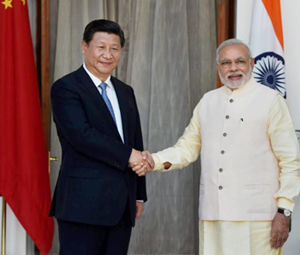Fourth India-China Strategic Economic Dialogue: Working Group on Infrastructure Challenges and Way Forward
Sakshi Education
India-China Strategic Economic Dialogue is a bilateral dialogue platform between the planning bodies of India and China- the Planning Commission of India (now Niti Aayog) and the National Development and Reform Commission (NDRC) of China.


The idea of having such a dialogue was first floated by Premier Wen Jiabao on his visit to India in 2010. As a result, the first India-China SED was held in 2011 in Beijing. It was initiated with the objective to discuss challenges and explore possibilities of cooperation between sectors that are strategically important for the economic growth of the two countries. Every year since 2011, the SED has been held alternatively in New Delhi and Beijing. The fourth round of this dialogue was held this year in New Delhi on 6th and 7th of October 2016. The dialogue which consisted of five working groups on the themes: Policy Coordination, Infrastructure, Urban Management, Energy, and Hitech, saw the participation of over 300 Chinese delegates.
The Working Group on Infrastructure held its deliberations on October 6th at Rail Bhawan, New Delhi. It saw an enthusiastic participation by key stakeholders from the Indian and Chinese side. The five thematic areas of discussion within this working group were: (1)Speed Raising (2) High-Speed Railways (3) Station Redevelopment (4) Highway and Road Development and (5) High-Speed Railway Training. Heavy haul freight train was an independent discussion topic in the previous working groups did not find its space in the dialogue this year.
One of the key areas of China- India infrastructure cooperation is speed raising on existing railway tracks. This area of collaboration is in tandem with the Ministry of Railways Mission Raftar that targets to increase the average speed of express trains by 25 kmph in the next five years. In the months that led to the SED, the China Railway Eryuan Engineering Group (CREEG) undertook a feasibility report for speed raising of the Chennai-Bangalore-Mysore railways. The feasibility report concluded in favor of speed raising and was appreciated by both sides. It was projected that at the end of the project, the speed of 12 passenger trains running between Chennai to Bangalore and Bangalore to Mysore would be raised by 25% - 50%. This will lead to significant reduction in travel time between these areas. This good news had to be taken with a pinch of salt. It was mentioned that in its current state the report is only an estimate of quantity aspects of feasibility. The important aspect of costs estimates has not yet been included in the report because of insufficient financial details for executing it. While the two sides looked optimistic about the interim report, actionable steps can be taken by India only after cost estimates have been taken into account. Without including those details, the report will only be an interim report. Furthermore, in selecting which partner to collaborate with India will also consider other countries like Germany which have shown interest in undertaking a feasibility study of speed raising in Chennai-Bangalore-Mysore railways.
China has also shown interest in New Delhi-Nagpur High-Speed Railway(HSR) project. The progress and challenges in preparing the feasibility report for this project were discussed in detail. The China Railway Siyuan Survey (CRSS) which is managing the China side of this project mentioned limited access to data as a major obstacle in the smooth preparation of this report. To facilitate in-depth and accurate study they required three types of data: topographical, geographical and transport volume data. Till now they have got limited access to such data from the Indian side. The Indian side promised to cooperate in providing the required data but also expressed the difficulty in arranging for such data. The key problem area was in providing topographical data. India has provided that data of 1:50,000 scale. The Chinese side wants it of a higher scale. That data is not available. The Chinese side also mentioned the availability of data from the Indian side in hard copy rather than an electronic copy as an impeding factor. The two sides agreed to have further consultations on ways to address this issue.
Station Redevelopment was another important thematic area in the discussion. This area of cooperation fits into the wider scheme of modernizing 400 railway stations of India in a way that would place them at par with the best transit hubs in the world. To kickstart this process, the Government of India set up the Indian Railway Station Development Corporation (IRSDC). ISDC has encouraged investors from China, France, Belgium, and Germany to take up projects in India. To make the selection process transparent and competitive, it was proposed to offer stations for redevelopment by inviting open bids from interested parties. One area of concern is that Chinese bidders are mostly state-owned enterprises, which makes the bidding by the Chinese side relatively opaque. In previous consultations, China Railway Construction Engineering Group (CREG) had stated it will redevelop New Bhubaneswar (Odisha) and Baiyappanahalli (Bengaluru) railway station. It further expressed interest in the redevelopment of other railway stations along the Delhi-Nagpur HSR and Bangalore- Chennai- Mysore railway line like Jhansi and Katpadi. It was mentioned that a decision would be made in this regard after a site visit to these stations has been made. The final list of the names of the stations for the redevelopment study will be identified by CREG and IRSDC in due course.
Highways and roads construction provide an enormous potential for cooperation between India and China. China has commendable expertise in this sector which can be leveraged for the benefit of India. Delegations of both sides made extensive discussion on this theme and confirmed the direction of further cooperation. Indian side highlighted that it encourages Chinese builders and investors to apply for internationally competitive bidding for construction of pre-fabricated materials of Indian bridges and roads. That will help in improving time and cost efficiency in future infrastructure projects. It also encouraged the Chinese manufacturers to move in India for the construction of these materials and take advantage of India’s cheap labor.
It was also decided to hold training on high-speed railways in China for 320 persons. Southwest Jiaotong University (SWJTU) will be the executing agency from China side. Both sides also agreed to have further cooperation in heavy haul training. The dialogue did not include details about setting up of a railway university in India even though the talks of setting up a railway university by China in India have been around since 2014. There are multiple universities in China that teach railway-specific courses. Chinese longstanding experience in designing curriculum and administration can be useful for setting up of India’s railway university. This SED could have been a great chance to get stakeholders from both sides to agree on the next steps of the project like the choice of location or nodal agencies who will take it forward but little was discussed on that.
The dialogue of the working group on infrastructure concluded on an optimistic note with both sides willing to cooperate in future consultations. Chinese appetite for undertaking infrastructure projects in India is high. India holds a special place in Chinese economic diplomacy that can be seen by the fact that besides India the only other country with which China has a SED is the United States. India must recognize the importance of this opportunity in engaging with China. Nevertheless, concerns remain on the Indian side over closer cooperation with China due to a hangover of China’s past actions. For that reason, there are apprehensions among policy makers over inviting Chinese capital in critical infrastructure projects like railways. Chinese opposition to India’s admission in the Nuclear Suppliers Group (NSG) and technical hold on India’s move to get Pakistan-based Jaish-e-Mohammad chief Masood Azhar listed as a terrorist by the United Nations are few examples of India’s breach of trust by China.
Political diplomacy aside, both India and China realize that as two of the largest emerging economies in the world they cannot do without engaging with each other. In this respect, the SED platform provides a powerful instrument of communication. However, for it to reap fruits, both sides need to ensure that this dialogue gives way to concrete actions of bilateral cooperation that yields positive spillovers for its citizens.
Source: NITI Aayog
The Working Group on Infrastructure held its deliberations on October 6th at Rail Bhawan, New Delhi. It saw an enthusiastic participation by key stakeholders from the Indian and Chinese side. The five thematic areas of discussion within this working group were: (1)Speed Raising (2) High-Speed Railways (3) Station Redevelopment (4) Highway and Road Development and (5) High-Speed Railway Training. Heavy haul freight train was an independent discussion topic in the previous working groups did not find its space in the dialogue this year.
One of the key areas of China- India infrastructure cooperation is speed raising on existing railway tracks. This area of collaboration is in tandem with the Ministry of Railways Mission Raftar that targets to increase the average speed of express trains by 25 kmph in the next five years. In the months that led to the SED, the China Railway Eryuan Engineering Group (CREEG) undertook a feasibility report for speed raising of the Chennai-Bangalore-Mysore railways. The feasibility report concluded in favor of speed raising and was appreciated by both sides. It was projected that at the end of the project, the speed of 12 passenger trains running between Chennai to Bangalore and Bangalore to Mysore would be raised by 25% - 50%. This will lead to significant reduction in travel time between these areas. This good news had to be taken with a pinch of salt. It was mentioned that in its current state the report is only an estimate of quantity aspects of feasibility. The important aspect of costs estimates has not yet been included in the report because of insufficient financial details for executing it. While the two sides looked optimistic about the interim report, actionable steps can be taken by India only after cost estimates have been taken into account. Without including those details, the report will only be an interim report. Furthermore, in selecting which partner to collaborate with India will also consider other countries like Germany which have shown interest in undertaking a feasibility study of speed raising in Chennai-Bangalore-Mysore railways.
China has also shown interest in New Delhi-Nagpur High-Speed Railway(HSR) project. The progress and challenges in preparing the feasibility report for this project were discussed in detail. The China Railway Siyuan Survey (CRSS) which is managing the China side of this project mentioned limited access to data as a major obstacle in the smooth preparation of this report. To facilitate in-depth and accurate study they required three types of data: topographical, geographical and transport volume data. Till now they have got limited access to such data from the Indian side. The Indian side promised to cooperate in providing the required data but also expressed the difficulty in arranging for such data. The key problem area was in providing topographical data. India has provided that data of 1:50,000 scale. The Chinese side wants it of a higher scale. That data is not available. The Chinese side also mentioned the availability of data from the Indian side in hard copy rather than an electronic copy as an impeding factor. The two sides agreed to have further consultations on ways to address this issue.
Station Redevelopment was another important thematic area in the discussion. This area of cooperation fits into the wider scheme of modernizing 400 railway stations of India in a way that would place them at par with the best transit hubs in the world. To kickstart this process, the Government of India set up the Indian Railway Station Development Corporation (IRSDC). ISDC has encouraged investors from China, France, Belgium, and Germany to take up projects in India. To make the selection process transparent and competitive, it was proposed to offer stations for redevelopment by inviting open bids from interested parties. One area of concern is that Chinese bidders are mostly state-owned enterprises, which makes the bidding by the Chinese side relatively opaque. In previous consultations, China Railway Construction Engineering Group (CREG) had stated it will redevelop New Bhubaneswar (Odisha) and Baiyappanahalli (Bengaluru) railway station. It further expressed interest in the redevelopment of other railway stations along the Delhi-Nagpur HSR and Bangalore- Chennai- Mysore railway line like Jhansi and Katpadi. It was mentioned that a decision would be made in this regard after a site visit to these stations has been made. The final list of the names of the stations for the redevelopment study will be identified by CREG and IRSDC in due course.
Highways and roads construction provide an enormous potential for cooperation between India and China. China has commendable expertise in this sector which can be leveraged for the benefit of India. Delegations of both sides made extensive discussion on this theme and confirmed the direction of further cooperation. Indian side highlighted that it encourages Chinese builders and investors to apply for internationally competitive bidding for construction of pre-fabricated materials of Indian bridges and roads. That will help in improving time and cost efficiency in future infrastructure projects. It also encouraged the Chinese manufacturers to move in India for the construction of these materials and take advantage of India’s cheap labor.
It was also decided to hold training on high-speed railways in China for 320 persons. Southwest Jiaotong University (SWJTU) will be the executing agency from China side. Both sides also agreed to have further cooperation in heavy haul training. The dialogue did not include details about setting up of a railway university in India even though the talks of setting up a railway university by China in India have been around since 2014. There are multiple universities in China that teach railway-specific courses. Chinese longstanding experience in designing curriculum and administration can be useful for setting up of India’s railway university. This SED could have been a great chance to get stakeholders from both sides to agree on the next steps of the project like the choice of location or nodal agencies who will take it forward but little was discussed on that.
The dialogue of the working group on infrastructure concluded on an optimistic note with both sides willing to cooperate in future consultations. Chinese appetite for undertaking infrastructure projects in India is high. India holds a special place in Chinese economic diplomacy that can be seen by the fact that besides India the only other country with which China has a SED is the United States. India must recognize the importance of this opportunity in engaging with China. Nevertheless, concerns remain on the Indian side over closer cooperation with China due to a hangover of China’s past actions. For that reason, there are apprehensions among policy makers over inviting Chinese capital in critical infrastructure projects like railways. Chinese opposition to India’s admission in the Nuclear Suppliers Group (NSG) and technical hold on India’s move to get Pakistan-based Jaish-e-Mohammad chief Masood Azhar listed as a terrorist by the United Nations are few examples of India’s breach of trust by China.
Political diplomacy aside, both India and China realize that as two of the largest emerging economies in the world they cannot do without engaging with each other. In this respect, the SED platform provides a powerful instrument of communication. However, for it to reap fruits, both sides need to ensure that this dialogue gives way to concrete actions of bilateral cooperation that yields positive spillovers for its citizens.
Source: NITI Aayog
Published date : 27 Oct 2016 04:28PM













